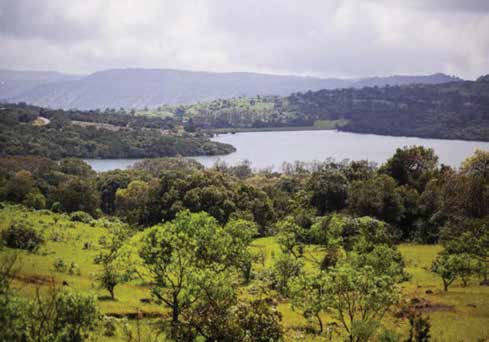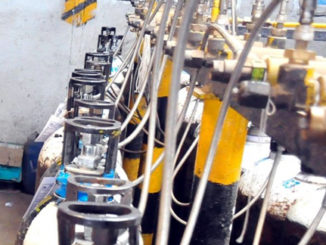
Once the monsoon casts its spell on the Sahyadris, the entire region puts on a brilliant show for anyone who has the time to stand and stare. Teeming and bustling with life, it is home to everything from lush rainforests and waterfalls to an incredible diversity of flora and fauna. But hidden in the heart of the Western Ghats is a picturesque plateau that blooms into a riot of colour only once a year. And the time to visit is right now.
As you are reading this, just over 280km from Mumbai, a natural phenomenon is painting an area of 1,000 hectares into a picture-perfect postcard that you can stroll into. The Kaas Pathar (‘pathar’ translates to plateau) is an ecological marvel houses over 850 varieties of plant life, of which around 600 are flowering plants.
 Picture this: dramatic, cloudy skies overlooking a green landscape that suddenly gets carpeted with colours to rival a rainbow— a splash of cheery yellows, tranquil whites, brilliant purples and more, as butterflies and birds flit about all around you. This is the sight that greeted us as we reached this conserved area which is listed among the UNESCO Biodiversity Heritage Sites.
Picture this: dramatic, cloudy skies overlooking a green landscape that suddenly gets carpeted with colours to rival a rainbow— a splash of cheery yellows, tranquil whites, brilliant purples and more, as butterflies and birds flit about all around you. This is the sight that greeted us as we reached this conserved area which is listed among the UNESCO Biodiversity Heritage Sites.
The road to heaven
The route to Kaas was a revelation in itself as we made our way up the ghats from Satara, the nearest town. We had intended to take the local bus from Satara to Tetli that stops en route to the Kaas Plateau. However, the Satara bus stop was a confused bustle of activity which neither had any signage in English nor any helpful staff. If you speak Marathi, you should manage just fine. Otherwise, it’s a bit of a challenge trying to find your way around here.
So, we hired an autorickshaw for `350 to climb up the 24km ghat route. As we made our way up, civilization shrunk away below, and the landscape started transforming rapidly. The air started getting cleaner and breathtaking views of the flat tabletop plateaus of the Sahyadri range opened up. We got a sneak peek of what we had in store in the form of tiny wildflower dotting the entire landscape. As auto rides go, this one was hard to beat.
We made it to the top of the hill to reach the Kaas Plateau, which is referred to only as the ‘Valley of Flowers’ for some reason on a board erected by Maharashtra Tourism. But you should know you’ve reached Kaas just with the view. All you can see is a green landscape, with an unbridled view of the open skies and, of course, lots of flowers.
Under nature’s spell
The Kaas Plateau makes for the most idyllic countryside stroll that would have had the Wordsworths and Coleridges of the world waxing lyrical and spouting odes. Once we bought the entry tickets (Rs10), we walked through the trail in the picket-fenced meadows leisurely. Endless beds of happy flowers cushion the slopes, interrupted only by winding creeks that add to the beauty.
The slower we walked, the more we noticed flowers that we would have missed at first glance. There was a surprise waiting for us everywhere we looked. Some of the tiniest blooms were no bigger than ladybugs. After walking for an hour or two, we took a break and plopped ourselves on a rock at the edge of the plateau overlooking the valley below.
Today, environmentalists warn that due to rapid climate change and man-made imbalances in the ecosystem, the Kaas Plateau won’t stay this pristine for long. Even this year, the flowers were delayed by the sparse rains. Many of the endemic flowering species are already considered endangered.
It makes us hold on to the memory of sitting at that spot — amid the incredible but transient beauty — that much more fiercely.
How to get there from Mumbai
By car: Around 4 hours | Drive down the Mumbai-Pune Expressway and take the NH4 upto Satara, where you can ask for directions to Kaas. From Satara, Kaas is a 22km drive up the hill.
By bus: Around 7 hours | There are plenty of overnight buses plying on the Mumbai-Satara route with boarding points all across the city. Switch buses at the Satara bus stand and catch a bus to Bamnoli. Check redbus.in.
By train: Around 8 hours | Catch the Koyna Express that departs from CST at 8.40am and arrives at Satara station by 4pm. You can catch a state transport bus to Bamnoli from Satara bus stand.
 Flower spotting
Flower spotting
MICKEY MOUSE FLOWERS (SMITHIA HIRSUTA): Cheery yellow and blooming in abundance, these flowers earn their Disney name from their unique red speckles that make them look like everyone’s beloved mouse.
SITA’S TEARS (UTRICULARIA PURPURASCENS): These pretty purple flowers are a far cry from the melancholy picture their name paints. Sita’s Tears are carnivores that feed on protozoa swimming in the wet soil.
TUBEROUS PIPEWORTS (ERIOCAULON TUBERIFERUM): Whimsical as a dream, these tiny ball-like blooms are spread over the Kaas landscape like a blanket of white.
Bombayensis (Senecio Grahamii): Akin to miniature sunflowers, the Sonki is a flowering plant of the Western Ghats that adds a splash of yellow to green landscapes during the monsoon.
INDIAN SUNDEW (DROSERA INDICA): The insectivorous Flycatcher — which uses sparkling dewdrop-like sticky liquid as a decoy to trap insects — makes for a super cool spotting.If you want to know the flowers even better, read Kaas: Plateau of Flowers by Dr Sandeep Shrotri, a guide with exhaustive information on the flowers of Kaas.
- Be a sensitive and sensible traveller in this biodiversity hotspot. Always follow the trail and don’t wander off as you may trample or damage delicate flowers and plants that are not easily visible to the eye.
- Please don’t pluck the flowers. They are not souvenirs to bring back to Mumbai.
- Eat your wafers if you must, but do not litter.
- Don’t be loud. And don’t blast Yo Yo Honey Singh from your phones. Others might have come here to enjoy the natural marvel in peace.





Be the first to comment